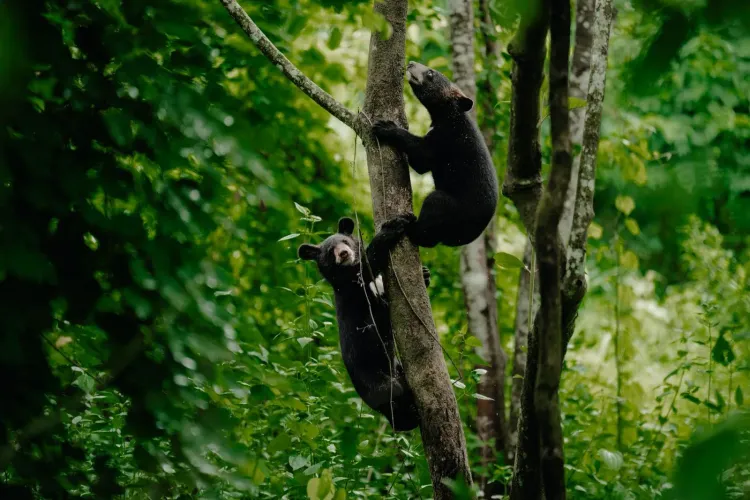What Happened to the Two Orphaned Asiatic Black Bears Released in Assam National Park?

Synopsis
Key Takeaways
- Successful rehabilitation of orphaned bears is crucial for wildlife conservation.
- Community support plays an essential role in wildlife management.
- Scientific protocols guide the rehabilitation process.
- Dehing Patkai National Park provides an ideal habitat for released bears.
- Assam is committed to protecting its wildlife heritage.
Guwahati, Aug 20 (NationPress) Two orphaned Asiatic black bear cubs, saved from the Dissoi Reserved Forest in Jorhat, have been successfully released into Dehing Patkai National Park after a six-month rehabilitation period at the Centre for Wildlife Rehabilitation and Conservation (CWRC) in Kaziranga, officials reported on Wednesday.
The Dehing Patkai National Park spans the Dibrugarh and Tinsukia districts of eastern Assam.
According to Kaziranga National Park and Tiger Reserve (KNPTR) Director Sonali Ghosh, the two orphaned Asiatic black bear (Ursus thibetanus) cubs, located in the Dissoi Reserved Forest in Jorhat on February 26, 2025, have embarked on a new journey after their relocation to Dehing Patkai National Park, marking a significant milestone in Assam's wildlife conservation efforts.
The cubs were discovered alone by a local resident and were promptly handed over to the Na-Kachari Beat Office within the Jorhat Forest Division. After thorough investigations revealed no sign of their mother, they were subsequently moved to CWRC in Kaziranga for expert care.
Established in 2002, CWRC is a collaborative effort of the Assam Forest Department, the International Fund for Animal Welfare (IFAW), and the Wildlife Trust of India (WTI).
At CWRC, the cubs received treatment for mild dehydration and were nurtured in a small mammal nursery under the attentive care of Dr. Bhaskar Choudhury and his team. They were fed a canine milk replacer and gradually acclimatized to conditions vital for their survival in the wild.
The protocol for rehabilitating orphaned Asiatic black bear cubs at CWRC adhered to the rehabilitation guidelines set by the Centre for Bear Rehabilitation and Conservation (CBRC) in the Pakke Tiger Reserve, Arunachal Pradesh.
Ghosh emphasized that the rehabilitation process was centered around ensuring appropriate nutrition, preserving natural behaviors, and minimizing human interaction to boost their chances of successful reintegration. A scientific survey was conducted to identify an appropriate release site. Although the Dissoi Reserved Forest was under consideration, its proximity to human settlements and heightened disturbances rendered it unsuitable for bear rehabilitation.
A systematic assessment of natural cover, distance from human habitation, prey availability, and local community awareness led to the identification of Dehing Patkai National Park as the optimal release site. This park offers abundant vegetation, plentiful natural resources, minimal human disturbance, and strong support from forest personnel and local communities, making it the ideal new home for the cubs, Ghosh noted.
Following approval from the Principal Chief Conservator of Forests (Wildlife) and Chief Wildlife Warden of Assam, the CWRC team successfully relocated the cubs to Dehing Patkai National Park on August 17, granting them a true opportunity to thrive in their natural habitat.
Ghosh remarked that the journey of these Asiatic black bear cubs—from their rescue in Jorhat, through their care at CWRC, to their release in Dehing Patkai National Park—exemplifies the success of science-driven rehabilitation, ethical wildlife management, and community engagement. It underscores Assam's growing dedication to preserving its wildlife heritage and ensuring that even orphaned animals are afforded a second chance at freedom, stated the senior Indian Forest Service (IFS) officer.










